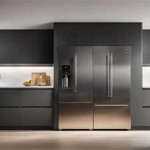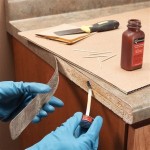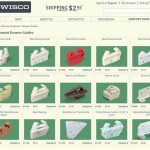Best Roller to Use When Painting Kitchen Cabinets
Achieving a professional, smooth finish on kitchen cabinets requires careful preparation, the right paint, and crucially, the appropriate roller. The roller's nap, material, and construction all contribute to the final appearance of the painted cabinets. Selecting the wrong roller can result in unwanted textures, uneven application, and ultimately, a less-than-desirable outcome. This article will explore various types of rollers and their suitability for painting kitchen cabinets, highlighting the factors to consider when making a selection.
The primary objective when painting kitchen cabinets is typically to attain a smooth, factory-like finish. This necessitates minimizing any texture imparted by the application tools. While spray painting is often considered the gold standard for achieving such finishes, it requires specialized equipment and a controlled environment. A high-quality roller, coupled with proper technique, can provide a comparable result, particularly for those undertaking a DIY project.
Before delving into specific roller types, it is important to address surface preparation. Thorough cleaning, sanding, and priming are essential steps, regardless of the chosen roller. Removing grease, grime, and existing finishes creates a clean, receptive surface for the paint to adhere to. Sanding smooths imperfections and provides "tooth" for the primer. Priming creates a uniform base, seals the surface, and enhances paint adhesion, ultimately contributing to a smoother finish.
Understanding Roller Nap and Material
The "nap" of a roller refers to the length of the fibers extending from the roller core. Shorter naps are generally preferred for smooth surfaces like kitchen cabinets, as they deposit less paint and create a finer texture. Longer naps, conversely, are better suited for textured surfaces like stucco or heavily grained wood, as they can reach into crevices and provide more substantial coverage.
For kitchen cabinets, a low-nap roller is crucial. A nap length of 1/4 inch to 3/8 inch is generally recommended. This range provides sufficient paint application without creating excessive texture. Rollers with naps shorter than 1/4 inch can be difficult to load with paint effectively, while those longer than 3/8 inch may leave a noticeable stippling effect.
The material of the roller cover also plays a significant role in the final finish. Common roller cover materials include microfiber, foam, and woven fabric. Each material offers unique characteristics that affect paint absorption, application, and texture.
Microfiber rollers are a popular choice due to their ability to hold a substantial amount of paint and release it evenly. They create a very smooth finish with minimal stippling. Microfiber rollers are also relatively durable and can be cleaned and reused multiple times, provided they are properly maintained.
Foam rollers are another option for achieving a smooth finish. They are particularly effective with oil-based paints and varnishes, as they resist solvent breakdown. However, foam rollers can sometimes create small air bubbles in the paint film, which may require additional smoothing. They also tend to hold less paint than microfiber rollers, requiring more frequent reloading.
Woven fabric rollers, typically made of polyester or a blend of polyester and nylon, are a versatile option suitable for a variety of paints and surfaces. They generally provide good paint pickup and release, but may leave a slightly more textured finish compared to microfiber or foam rollers. The quality of woven fabric rollers can vary significantly, so it's important to choose a reputable brand and opt for a higher-quality cover.
Evaluating Roller Core and Construction
Beyond the nap and material, the roller core and overall construction also impact performance. A solid, well-constructed roller core prevents slippage and ensures even paint distribution. Look for rollers with durable plastic or phenolic cores that can withstand repeated use and cleaning.
The end caps of the roller should be securely attached to the core to prevent paint from seeping inside and causing swelling or deformation. Reinforced end caps are a desirable feature, as they provide added durability and prevent premature wear and tear.
The frame or handle of the roller should be comfortable to hold and provide adequate leverage. Ergonomic handles are designed to reduce fatigue during extended painting sessions. A sturdy frame ensures that the roller cover remains securely attached and rotates smoothly.
Some rollers feature a cage design that allows for easy roller cover replacement. These designs typically involve a spring-loaded mechanism or a simple snap-on system. Easy roller cover replacement is a valuable feature, especially for larger projects or when switching between different paints or finishes.
Consider also the size of the roller. While standard 9-inch rollers are suitable for large, flat surfaces, smaller rollers, such as 4-inch or 6-inch rollers, are better suited for painting cabinet doors and frames. These smaller rollers provide greater maneuverability and allow for more precise application in tight spaces.
Specific Roller Recommendations for Kitchen Cabinets
Based on the above considerations, microfiber rollers with a 1/4-inch or 3/8-inch nap are generally considered the best choice for painting kitchen cabinets. They provide a smooth, even finish with minimal stippling and are compatible with a wide range of paints and primers.
For those using oil-based paints or varnishes, a high-density foam roller may be a suitable alternative. Ensure to work quickly and evenly to minimize the formation of air bubbles. A light sanding between coats may be necessary to remove any imperfections.
When using water-based paints or primers, a high-quality woven fabric roller can also provide satisfactory results. Choose a roller with a tight weave and a short nap to minimize texture. Experiment on a small, inconspicuous area to assess the finish before applying the paint to the entire cabinet.
Regardless of the chosen roller type, it is essential to "break in" the roller before use. This involves wrapping the roller in painter's tape and then removing it to remove any loose fibers that could end up in the paint finish. Alternatively, the roller can be lightly dampened with water and rolled across a clean surface to remove any debris.
Proper roller technique is also crucial for achieving a smooth finish. Avoid overloading the roller with paint, as this can lead to drips and uneven application. Apply the paint in thin, even coats, overlapping each pass slightly. Work in small sections and feather the edges to blend each section seamlessly.
Between coats, wrap the roller tightly in plastic wrap to prevent the paint from drying out. This allows you to continue using the same roller for multiple coats without having to clean it each time. For longer breaks or at the end of the project, clean the roller thoroughly with the appropriate solvent. Follow the manufacturer's instructions for cleaning and storage to prolong the life of the roller.
In summary, selecting the right roller for painting kitchen cabinets is a critical step in achieving a professional-looking finish. Microfiber rollers with a short nap are generally the preferred choice for their ability to create a smooth, even surface. However, foam rollers and high-quality woven fabric rollers can also be effective options, depending on the type of paint being used and the desired finish. Careful consideration of roller nap, material, core construction, and proper technique will contribute to a successful and aesthetically pleasing cabinet painting project.

The Best Paint Roller For A Smooth Finish On Cabinets And Furniture

Best Type Of Roller For Painting Cabinets Quick Guide Prudent Reviews

The Best Roller For Painting Cabinets

The Best Paint Rollers For Cabinets Jenna Sue Design

The Best Paint Rollers For Cabinets Jenna Sue Design

Best Rollers For Painting Cabinets Top 8 What To Look

Best Type Of Roller For Painting Cabinets Quick Guide Prudent Reviews

Best Type Of Roller For Painting Cabinets Quick Guide Prudent Reviews

The Best Paint Rollers For Cabinets Including From Brands Like Purdy And Foampro

Should I Use A Brush Or Roller To Paint Cabinets Upvc Sprayers
Related Posts








